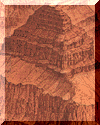
Updated on 05.05.15

|
|
Poorna's Physical Geology Pages |
Updated on 05.05.15 |
 |
| The Geological Scale of Time | |||
|
Home My Book Geol-101 (Earth Revealed Telecourse) Geol-101 (Physical Geology) Geol-102 (Environmental Geology) Geol-112 (Environmental Geology Lab) Ocean-115 (Oceanography) |
|
||
|
|
|||
|
On this page: |
|||
|
Poorna's Outlines:
You may need to download the Adobe Acrobat Reader to view this document. |
Click on the image on the right to browse the online edition of USGS publication "Geological Time" |
 |
Estimating the Earth's Age
|
Lead-ratio (or the Pb207-Pb206 isochron) method provides the most direct means to estimate the Earth's age. As Pb207 comes from radioactive decay of U235 and Pb206 from that of U238, the plot of these two lead isotopes (relative to the non-radiogenic Pb204 or Pb208) should be linear if the solar system formed from a common pool of matter that was uniformly distributed in terms of the Pb-isotope ratios. The older the sample, the higher the uranium-to-lead ratio and Pb206/Pb204 and Pb207/Pb204 values will be. |

|
|
The slope of the straight-line fit to 5 meteorite and one terrestrial data thus yields an estimate of ~4.55 Ga. This is also the result from dating of meteorite samples by Rb-Sr and other radiometric methods. |
|
Geological Time and the Evolution of Life
Gradualism, Punctuated Equilibrium and Mass Extinctions:
|
|
|
|
|
|
Want to visit the Grand Canyon?
Click on this profile of the Colorado plateau, shown on the left, to learn about the geology of the Grand Canyon of Colorado river.